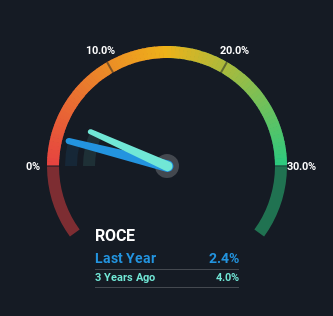Tsubaki Nakashima's (TSE:6464) Returns On Capital Not Reflecting Well On The Business

If you're looking for a multi-bagger, there's a few things to keep an eye out for. In a perfect world, we'd like to see a company investing more capital into its business and ideally the returns earned from that capital are also increasing. Ultimately, this demonstrates that it's a business that is reinvesting profits at increasing rates of return. However, after briefly looking over the numbers, we don't think Tsubaki Nakashima (TSE:6464) has the makings of a multi-bagger going forward, but let's have a look at why that may be.
Understanding Return On Capital Employed (ROCE)
For those that aren't sure what ROCE is, it measures the amount of pre-tax profits a company can generate from the capital employed in its business. The formula for this calculation on Tsubaki Nakashima is:
Return on Capital Employed = Earnings Before Interest and Tax (EBIT) ÷ (Total Assets - Current Liabilities)
0.024 = JP¥3.5b ÷ (JP¥178b - JP¥33b) (Based on the trailing twelve months to March 2024).
Therefore, Tsubaki Nakashima has an ROCE of 2.4%. Ultimately, that's a low return and it under-performs the Machinery industry average of 8.0%.
Check out our latest analysis for Tsubaki Nakashima

Above you can see how the current ROCE for Tsubaki Nakashima compares to its prior returns on capital, but there's only so much you can tell from the past. If you're interested, you can view the analysts predictions in our free analyst report for Tsubaki Nakashima .
What Can We Tell From Tsubaki Nakashima's ROCE Trend?
Unfortunately, the trend isn't great with ROCE falling from 7.9% five years ago, while capital employed has grown 21%. Usually this isn't ideal, but given Tsubaki Nakashima conducted a capital raising before their most recent earnings announcement, that would've likely contributed, at least partially, to the increased capital employed figure. The funds raised likely haven't been put to work yet so it's worth watching what happens in the future with Tsubaki Nakashima's earnings and if they change as a result from the capital raise.
The Bottom Line
To conclude, we've found that Tsubaki Nakashima is reinvesting in the business, but returns have been falling. Since the stock has declined 52% over the last five years, investors may not be too optimistic on this trend improving either. All in all, the inherent trends aren't typical of multi-baggers, so if that's what you're after, we think you might have more luck elsewhere.
Like most companies, Tsubaki Nakashima does come with some risks, and we've found 2 warning signs that you should be aware of.
While Tsubaki Nakashima isn't earning the highest return, check out this free list of companies that are earning high returns on equity with solid balance sheets.
Valuation is complex, but we're here to simplify it.
Discover if Tsubaki Nakashima might be undervalued or overvalued with our detailed analysis, featuring fair value estimates, potential risks, dividends, insider trades, and its financial condition.
Access Free AnalysisHave feedback on this article? Concerned about the content? Get in touch with us directly. Alternatively, email editorial-team (at) simplywallst.com.
This article by Simply Wall St is general in nature. We provide commentary based on historical data and analyst forecasts only using an unbiased methodology and our articles are not intended to be financial advice. It does not constitute a recommendation to buy or sell any stock, and does not take account of your objectives, or your financial situation. We aim to bring you long-term focused analysis driven by fundamental data. Note that our analysis may not factor in the latest price-sensitive company announcements or qualitative material. Simply Wall St has no position in any stocks mentioned.
Have feedback on this article? Concerned about the content? Get in touch with us directly. Alternatively, email editorial-team@simplywallst.com
About TSE:6464
Tsubaki Nakashima
Manufactures and sells industrial precision balls, rollers, blowers, and medical equipment and hygiene equipment in Japan and internationally.
Good value second-rate dividend payer.
Similar Companies
Market Insights
Community Narratives




